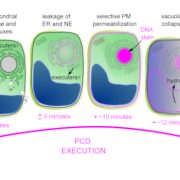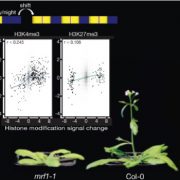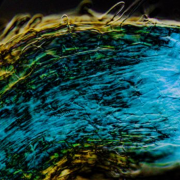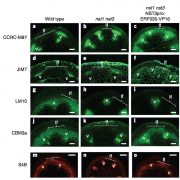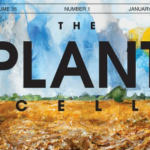A Lightclub in the nucleus: protein liaisons optimizing plant photo-responses
Fang et al. investigate how TZP modulates Arabidopsis seedling growth in response to red light and long days. https://doi.org/10.1093/plcell/koac236
By Weiwei Fang and Eirini Kaiserli, University of Glasgow, Scotland, UK
Background: Plants sense, respond and adapt to the environment by changing their body shape and life cycle timing. Plant photoreceptors sense and communicate changes in light to proteins that control growth and life cycle events. Phytochrome B (phyB) detects red light and warmer temperatures and works with the transcription factor PHYTOCHROME INTERACTING FACTOR 4 (PIF4), the scaffold protein PHOTOPERIODIC CONTROL OF HYPOCOTYL1 (PCH1) and the transcriptional regulator TANDEM ZINC-FINGER/PLUS3 (TZP). These four proteins meet up in nuclear neighborhoods and help seedlings adapt to changes in light and temperature. TZP controls gene expression and seedling growth in blue and far-red light. Very little is known about the role of TZP in communicating with phyB, PIF4 and PCH1 to optimize seedling growth in red light and during day/night cycles.
Question: How does TZP influence phyB, PIF4 and PCH1 in regulating growth in response to red light? Is TZP an information hub for different light signals in Arabidopsis?
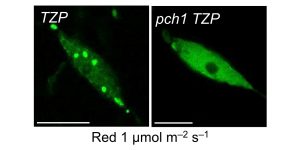 Findings: We reveal a new role for TZP in fine-tuning seedling growth under red light and long days through a reciprocal relationship with PCH1. We also show that TZP affects the abundance and residency of phyB in nuclear neighborhoods and influences how much PIF4 protein is available in response to red light and long days. The effect of TZP on phyB, PIF4, PCH1 regulation leads to changes in seedling architecture and growth. Overall, we discovered that TZP as a positive regulator of red light signaling by enhancing the communication between TZP, phyB and PCH1. Therefore, TZP is key in connecting information from different light qualities (blue, red, far-red) and seasonal changes to optimize growth.
Findings: We reveal a new role for TZP in fine-tuning seedling growth under red light and long days through a reciprocal relationship with PCH1. We also show that TZP affects the abundance and residency of phyB in nuclear neighborhoods and influences how much PIF4 protein is available in response to red light and long days. The effect of TZP on phyB, PIF4, PCH1 regulation leads to changes in seedling architecture and growth. Overall, we discovered that TZP as a positive regulator of red light signaling by enhancing the communication between TZP, phyB and PCH1. Therefore, TZP is key in connecting information from different light qualities (blue, red, far-red) and seasonal changes to optimize growth.
Next steps: Investigating how TZP regulates phyB protein independently or collaboratively with PCH1 will provide more information on their relationship and function. We are currently exploring whether TZP is a hub for light and temperature information and a potential candidate for improving plant survival to changing light availability and climate change.
Reference:
Weiwei Fang, Elisa Vellutini, Giorgio Perrella, and Eirini Kaiserli (2022). TANDEM ZINC-FINGER-PLUS3 Regulates Phytochrome B Abundance and Signaling to Fine-tune Hypocotyl Growth. Plant Cell, https://doi.org/10.1093/plcell/koac236


